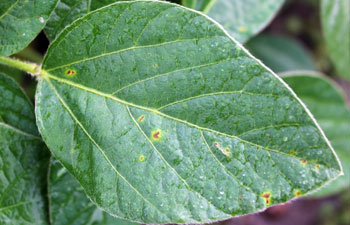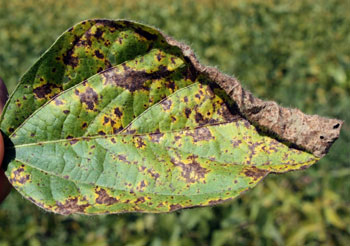Bacterial blight and Septoria brown spot appearing in soybeans
With all the rain Michigan’s received, a number of foliar diseases are popping up in soybeans, including two of the most common early season diseases: bacterial blight and Septoria brown spot.
Bacterial blight
Bacterial blight, caused by Pseudomonas syringae, is a bacterial pathogen that is seedborne and can overwinter on soybean debris in the field. The Pseudomonas syringae bacterium is capable of surviving on the surface of the soybean leaf and infecting when conditions are right, either through natural openings such as stomata or through damage caused by hail, wind and cultivation. The relatively cool temperatures we have been experiencing together with rain, wind and in some instances hail have been ideal for this disease.
Young soybean leaves are most susceptible to this pathogen and lesions can often be found on the mid- to upper canopy. Bacterial blight can be identified by the typical small, brown, angular lesions with a yellow halo, and as disease progresses, lesions can grow together with diseased centers eventually falling out, which gives the leaves a tattered appearance.


Symptoms of bacterial blight on soybean leaf. Photo credit: Martin Chilvers, MSU
Management of bacterial blight is limited to core integrated pest management practices as fungicides are not effective against this bacterial pathogen. No cultivars are completely resistant to bacterial blight; however, some cultivars demonstrate greater resistance or susceptibility than others. Crop rotation to non-hosts such as corn, wheat and other non-legume species will help reduce inoculum. Tillage where possible can also help reduce survival of Pseudomonas syringae-infested debris through burial and rapid breakdown of soybean debris.
Septoria brown spot
Septoria brown spot is another disease that is very common throughout Michigan. The disease is caused by the fungus Septoria glycines, which resides in overwintered soybean leaf and stem debris. During rainfall events, spores of Septoria glycines are splashed from the debris up into the lower canopy of the soybean plant where they are able to infect and cause Septoria brown spot symptoms.
Septoria brown spot symptoms consist of small, brown, irregular spots that can turn the leaf yellow and cause premature leaf drop. The disease is often present, but primarily on the lower canopy, and if weather conditions are warm and dry, it rarely moves into the upper canopy. Septoria brown spot, although common in the lower soybean canopy, is generally thought to have a minimal yield impact. However, under situations of high disease pressure, yield losses of 1 to 9 percent may occur. Heavy and frequent rainfall later in the season (e.g., August) has in some instances allowed Septoria glycines spores to be splashed up into the upper canopy, allowing Septoria brown spot disease to develop on upper leaves.


Symptoms of Septoria leaf spot on soybean leaf. Photo credit: Martin Chilvers, MSU
Management of Septoria brown spot includes use of crop rotation to corn, wheat, other small grains and alfalfa. Tillage where possible can assist in breaking down soybean residue and thereby reducing subsequent overwintering of disease inoculum. Fungicides can be used to assist in control of Septoria brown spot; however, studies in Michigan and Ohio have demonstrated that significant yield effects may only occur half of the time. This season, Michigan State University Extension has foliar fungicide trials in multiple locations across the state to examine control of Septoria brown spot and any potential yield benefits.



 Print
Print Email
Email
